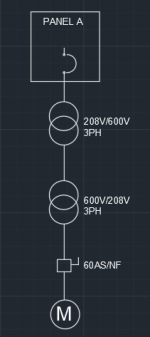Hello All
I've reviewed this single line diagram, which shows two transformers being used because the motor is far away and there isn't enough room to use a large wire size due to the existing conduit constraints. However, I have some concerns: the panel only has a circuit breaker (CB) and the main disconnect switch at the motor is not fused.
Does the NEC require that the disconnect switch at the motor be fused? Additionally, is it necessary for the secondary side of the transformers to have a disconnect switch or a circuit breaker?
I know it's not ideal because if there is a fault, the breaker in panel A will trip, making it difficult to identify where the fault is. But regarding the code, what does it say?

I've reviewed this single line diagram, which shows two transformers being used because the motor is far away and there isn't enough room to use a large wire size due to the existing conduit constraints. However, I have some concerns: the panel only has a circuit breaker (CB) and the main disconnect switch at the motor is not fused.
Does the NEC require that the disconnect switch at the motor be fused? Additionally, is it necessary for the secondary side of the transformers to have a disconnect switch or a circuit breaker?
I know it's not ideal because if there is a fault, the breaker in panel A will trip, making it difficult to identify where the fault is. But regarding the code, what does it say?






